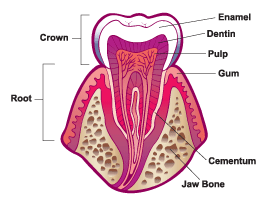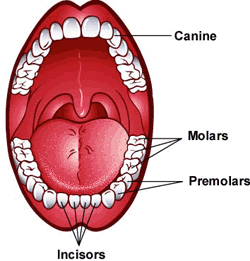Is It Bad for You to Still Have Baby Teeth at 13
You seize with teeth into an apple and then try to offset talking to your friend nigh yesterday's math homework. Suddenly something feels funny — one of your baby teeth has fallen out! Information technology'due south been loose forever, and now in that location it is, right in your hand. And you lot accept an empty space in your oral fissure big plenty to poke a drinking harbinger through.
Before y'all put that tooth under your pillow, did you lot know that there is much more to that molar than meets the heart? A single tooth has many different parts that make information technology piece of work. And teeth play an important role in your daily life. They not simply let y'all consume stuff like apples, they likewise assist yous talk. So let's talk teeth!
Tiny Teeth
Unlike your middle or brain, your teeth weren't ready to work from the day you were born. Although babies have the beginnings of their outset teeth even before they are born, teeth don't become visible until babies are most 6 to 12 months old.
Later that first molar breaks through, more than and more teeth begin to appear. Most kids have their start prepare of teeth past the time they are 3 years old. These are called the primary teeth, infant teeth, or milk teeth and there are 20 in all. When a child gets to age v or 6, these teeth start falling out, one by i.
A principal molar falls out because information technology is being pushed out of the way by the permanent tooth that is behind information technology. Slowly, the permanent teeth grow in and accept the place of the primary teeth. By about age 12 or 13, most kids have lost all of their baby teeth and have a full set of permanent teeth.
At that place are 32 permanent teeth in all — 12 more the original fix of babe teeth. Most people take four teeth (called wisdom teeth) abound in at the back of the mouth when they're between 17 and 25 years old. These complete the adult set of 32 teeth.
Page 1
Tooth Tour
Let's take a bout of your teeth. Look in the mirror at your own teeth or cheque out a friend's grin. The part of the tooth you can run across, which is non covered by the mucilage (your gums are the pink, fleshy part), is called the crown. The crown of each tooth is covered with enamel (say: ih-NAM-ul), which is very difficult and often shiny. Enamel is a very tough substance and it acts as a tooth'due south personal babysitter. Enamel works every bit a bulwark, protecting the inside parts of the tooth.

If you lot were able to peel away the enamel, y'all would observe dentin (say: DEN-tin). Dentin makes up the largest part of the tooth. Although it is non as tough every bit enamel, information technology is also very hard.
Dentin protects the innermost office of the tooth, called the pulp. The pulp is where each tooth'south nervus endings and blood supply are found. When you eat hot soup, bite into a super-cold scoop of water ice cream, fall and hurt a tooth, or get a cavity, it'due south your pulp that hurts. The nerve endings inside the pulp send messages to the brain about what's going on ("That ice cream is too cold!"). The pulp also contains the molar'southward claret vessels, which feed the molar and keep it live and salubrious.
The pulp goes all the way downwardly into the root of the tooth, which is under the gum. Cementum (say: sih-MEN-tum) makes upward the root of the molar, which is anchored to the jawbone.
Page 2
Tooth Types
You've probably noticed that you take different types of permanent teeth in your mouth. Each ane has its own office.
Your two front teeth and the teeth on either side of them are incisors (say: in-SY-zurs). At that place are four on the top and four on bottom.

Incisors are shaped similar tiny chisels, with apartment ends that are somewhat abrupt. These teeth are used for cut and chopping food. Think dorsum to that apple tree you ate: You lot used your incisors to crisis into the skin of the apple.
The pointy teeth beside your incisors are called canine (say: KAY-nine) teeth. At that place are four of them, two on top and two on bottom. Because these teeth are pointy and too abrupt, they help tear food.
Side by side to your canine teeth are your premolars (say: PREE-mo-lurs), which are also called bicuspid teeth. You have 8 premolars in all, four on meridian and four on the bottom. You'll need to open a bit wider to see these teeth, but when you exercise, you lot'll notice that their shape is completely different from both incisors and canines. Premolars are bigger, stronger, and accept ridges, which make them perfect for crushing and grinding food.
If you open your mouth actually wide, you'll run across your molars (say: MO-lurs). You lot have eight of these, four on the top and four on the bottom. Sometimes these are called your 6-year molars and your 12-year molars because that is effectually the time when they come up in.
Molars are the toughest of the bunch. They are even wider and stronger than premolars, and they take more ridges. Molars work closely with your tongue to help you consume food. How? The natural language sweeps chewed-up food to the dorsum of your oral fissure, where the molars grind it until it'due south mashed up and ready to exist swallowed.
As we mentioned earlier, the concluding teeth a person gets are wisdom teeth. These are likewise called third molars. They are all the way in the back of the mouth, 1 in each corner.
Wisdom teeth may have to exist removed because they can crusade issues in a person's mouth. Some people believe that wisdom teeth may accept been used by people millions of years ago when humans had larger jaws and ate nutrient that needed a lot of chewing. It's believed that they're chosen wisdom teeth because they come in later in life, when a young person is becoming older and wiser.
p
Tooth Talk
Your teeth are neat for chewing, but you lot also need them to talk. Different teeth work with your natural language and lips to aid y'all form sounds. Endeavor saying the word "tooth" slowly and notice how your tongue first hits the inside of your incisors to produce the hard "t" sound and then goes in between your upper and lower teeth to make the "thursday" sound.
And if you love to sing "la la la la la," you can thank those teeth every fourth dimension y'all sing a song. Pay attending to what happens to your teeth and natural language every time yous make the "l" sound.
Treating Teeth Kindly
Brushing your teeth with fluoride toothpaste is your best bet when it comes to keeping your teeth in tip-top shape. Try to brush after eating or at least twice a solar day. It'southward specially important to brush earlier bedtime.
The best manner to castor your teeth is in little circles — go around and around until you have covered every surface of every molar. Brush up and down, rather than side to side. You'll also want to clean between your teeth with dental floss (a special cord for cleaning your teeth) at least once a day. That removes food and plaque (sticky stuff that tin can crusade cavities or glue disease) that get stuck in betwixt your teeth. You can as well brush your tongue to aid keep your breath fresh! Your dentist may suggest that you employ an alcohol-free mouth rinse.
It'south too important to visit your favorite tooth experts — your dentist and dental hygienist. During your appointment, they'll look out for whatever problems and make clean and shine your teeth. Sometimes the dentist will have X-rays to get a better picture of what is going on in your mouth. You lot also might get a fluoride treatment while you lot're there.
In between dentist visits, you can prevent problems by eating fewer sugary snacks and sugary drinks, such as soda. Carbohydrate can hurt your teeth and cause molar decay, or cavities. Simply if y'all take care of your teeth now, you'll exist chewing like a champ for the remainder of your life!
Source: https://kidshealth.org/en/kids/teeth.html
0 Response to "Is It Bad for You to Still Have Baby Teeth at 13"
Post a Comment